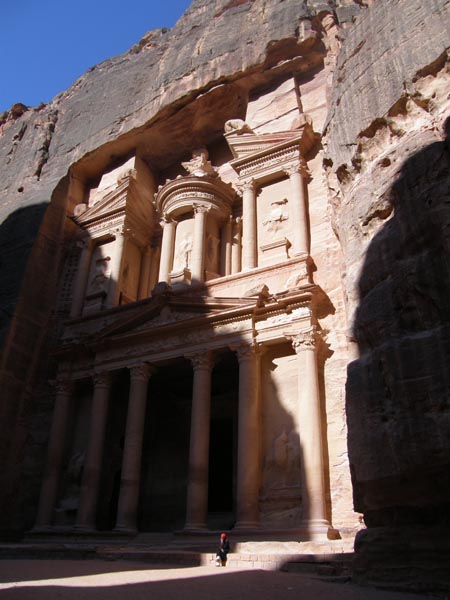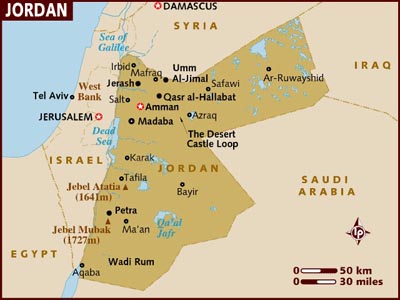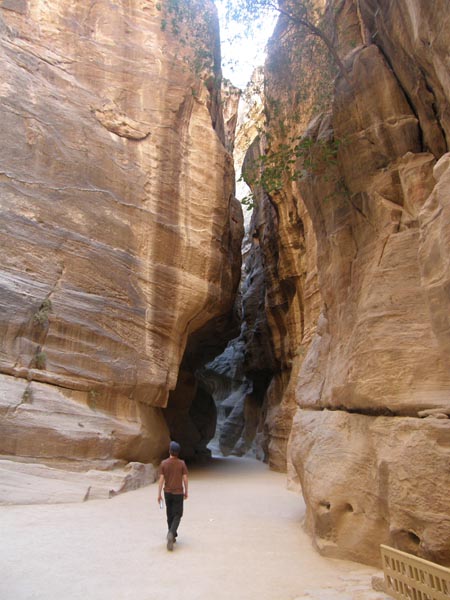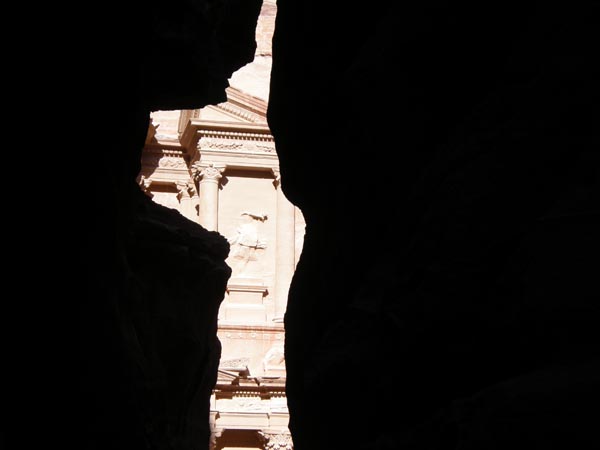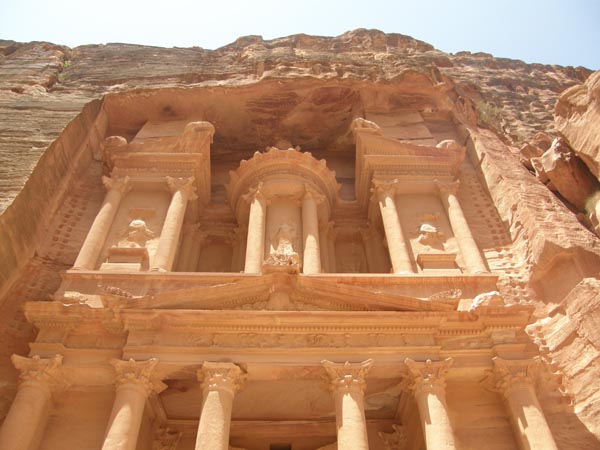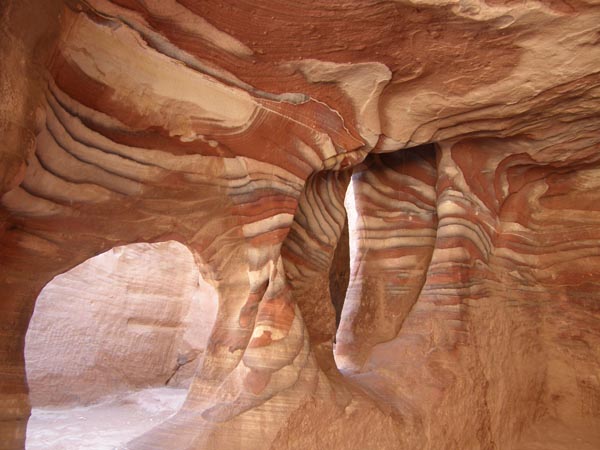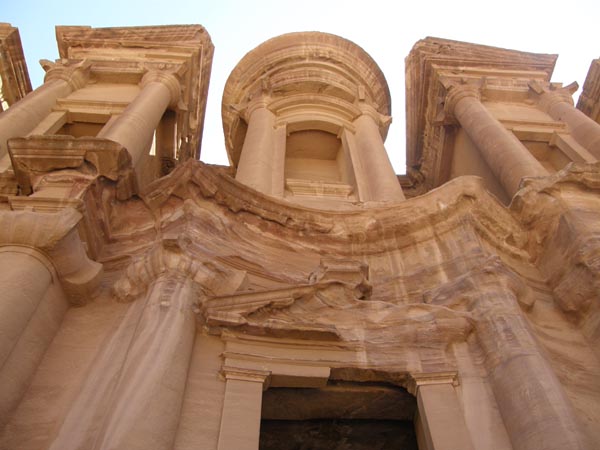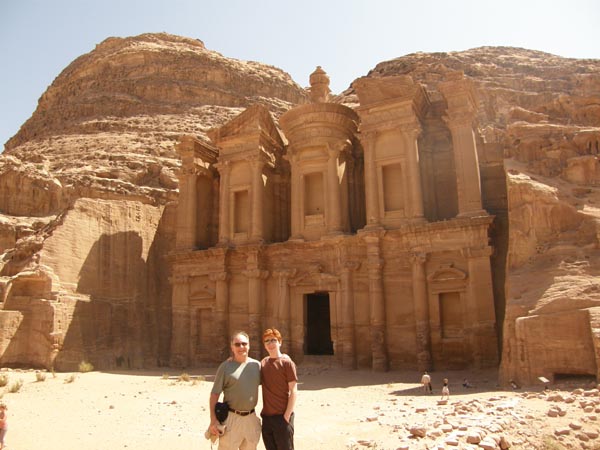EAST OF THE DEAD SEA
[This Monday’s Archive was originally published on July 3, 2008. This history of Jordan is particularly apropos because of Saturday’s (11/25) worldwide news: Dutch Right-Wing Election Winner Geert Wilders Causes Uproar After Declaring ‘Jordan Is Palestine!’ Arab Countries Freak. Of course it is, Wilders is right, but Jordan already has a massive refugee influx of 2 million from Iraq and Syria. There are 3 million Palestinian Arabs in Israel’s so-called West Bank and 2 million in Gaza. With a population of 11.5 million already crammed into a mostly barren desert country smaller than Indiana, how could Jordan handle 5 million more? That noted, enjoy the history – and the photos!]
TTP July 3, 2008
The 2,000 year-old Rose Red City of Petra was the religious center of an ancient desert people named Nabataeans. They didn’t build huge temples such as this – they carved them out of cliffs of rose-red sandstone in their hidden mountain sanctuary east of the Dead Sea.
Their capital was the ancient city of Ammon, known to the Greeks and Romans as Philadelphia, after the Hellenistic ruler of Egypt, Ptolemy II Philadelphus (309-246 BC).
Nabataea flourished until it was conquered by the Roman Emperor Trajan (53-117 AD). The Nabataeans converted to Christianity and lived as peaceful farmers until they were overrun by Arab invaders in the 7th century who forced them to submit to Islam.
They vanished, and so did any memory of Petra until it was discovered by a Swiss explorer, Johann Burckhardt, in 1812. Ammon, pronounced Amman (ah-man vs. ah-mone) by the Arabs, had been reduced to rubble by a series of earthquakes during the Middle Ages, and remained a small village with some Roman ruins for centuries.
The entire area east of the Dead Sea was a forgotten desert wasteland, incorporated into the Ottoman Empire in the early 1500s and ignored by the Sultans in Istanbul. Finally, in 1900, Sultan Abdul Hamid II decided to construct a railway from Damascus to Mecca, connecting Islam’s holy city to the rest of the Turkish empire. Amman was designated to be a major station on the “Hejaz Railway” (Mecca is in a region of western Arabia called the Hejaz).
The rulers, or sharifs, of Mecca were appointed by the Sultan, and traditionally came from a family named Hashem which claimed descendance from Mohammed. When World War I broke out, with the Ottomans joining the Germans against England, the Sharif of Mecca was Hussein bin Ali al-Hashemi (1854-1931).
In 1916, the Sharif had a visitor, a young British officer assigned to the Foreign Ministry’s Arab Bureau named Thomas Edward Lawrence. Britain was planning to break apart the Ottoman Empire after the war, Lawrence informed the Sharif, and if he, the Sharif joined Britain and rebelled against the Turks, then he would be granted his fondest wish: to be ruler of his own kingdom, to be King of the Hejaz.
And the British ferenji (foreigner) promised an even greater prize: Damascus, the historic capital of the Arabs, and a huge kingdom of Greater Syria surrounding it, would be given to the greatest warrior among his sons who would lead the revolt.
So the old Sharif ordered his son Faisal to lead a rebellion, primarily blowing up Turkish trains on the Hejaz railway. A young enterprising American journalist in Damascus named Lowell Thomas got wind of it and began writing wildly romanticized dispatches about the “Arab Revolt” led by “Prince Faisal” and a heroic British captain dressed in flowing white Arab robes whom Thomas entitled “Lawrence of Arabia.”
But it turned out that the Brits – perfidious Albion – had made other promises. On November 2, 1917, they issued a formal statement of government policy declaring support for “a national home for the Jewish people” in an Ottoman region known as Palestine (from the Romans renaming Judaea after the long-dead Philistines: see Philistines and Palestinians, December 2006). The declaration was signed by Foreign Secretary Arthur Balfour, thus becoming known as the Balfour Declaration.
Further, another victor of the war demanded its share of the Ottoman spoils: the French.
While the Brits could keep Palestine, the French said, they wanted Damascus and all of Syria – including a region called Lebanon to be a “safe haven” for its Maronite (Syrian Catholic) Christians.
So before the French could get the newly-formed League of Nations to give them legal right to this, the Brits pulled a fast one. They paid off a bunch of Syrians to form a “Syrian National Congress” which declared on March 7, 1920 the creation of The Hashemite Kingdom of Syria with Faisal as King.
The very next month, the League of Nations convened a conference in San Remo, Italy, which gave France a formal “Mandate” (a disguised form of colonial ownership) to Syria and Lebanon – and Britain a Mandate for Palestine and Mesopotamia.
The French then demanded the dissolution of Faisal’s “Hashemite Kingdom” and that Faisal leave Damascus. When he refused, they began organizing an army in Beirut. And when Faisal’s older brother (by one year) Abdullah heard that, he decided to come to his brother’s rescue.
Assembling an army of a few dozen armed men and 60 camels, Abdullah left Mecca to race across the blazing deserts of northern Arabia and eastern Palestine. But he never made it to Damascus. He was passing by Petra when he got the news: a Maronite army led by French officers had defeated his brother’s forces in the Battle of Maysalun on July 23, 1920.
By the time Abdullah reached Amman, he learned that the Brits had rescued Faisal and flown him back to London. (A year later in August 1921, keeping their promise to give him a kingdom, they installed him as king of their Mandate of Mesopotamia, renaming the new-born country the Hashemite Kingdom of Iraq.)
So here Abdullah was stuck in Amman with nowhere to go and nothing to do. He didn’t want to back to Mecca at all, with his father King of the new Hashemite Kingdom of the Hejaz and his older brother Ali designated as his father’s successor.
He looked around and thought, Why not stay here? He sent a message to the British Governor of Palestine, Ronald Storrs, in Jerusalem that he was going keep eastern Palestine for himself.
Storrs exploded. Eastern Palestine – the land east of the Jordan River, the Dead Sea, and a line from the Dead Sea to an arm of the Red Sea called the Gulf of Aqaba – made up over 90,000 of the Mandate’s 120,000 square kilometers. This “mosque-keeper” (the Hashem family was in charge of the mosques in Mecca) had just seized over three-quarters of his Mandate! With 60 camels!
Storrs could crush him like a bug, but knew he could not act without orders from above, so he forwarded Abdullah’s message to Britain’s Secretary of State for Colonies, Winston Churchill. Churchill responded by inviting Abdullah to London.
At a “tea party” in November 1920, Churchill agreed to Abdullah’s control of eastern Palestine – in exchange for Abdullah’s agreement with Churchill’s reasoning and strategy for doing so.
The Palestine Mandate – all of it – had been promised to the Jews as their National Homeland. The Jews, however, couldn’t hope to populate all of it, nor would they want to – after all, most all of eastern Palestine is empty desert. The Jews wanted Jerusalem and western Palestine, the land west of the Jordan River and the Dead Sea all the way to the Mediterranean.
Agree to let them keep that, agree to not interfere with Jewish immigration to and in the affairs of western Palestine, Churchill told Abdullah, and you can keep the east, all three quarters of the Mandate.
Churchill then added the sweetener. The creation of this new Arab state – Churchill suggested it be called Trans-Jordan – will attract the Arabs of western Palestine to emigrate out of it, away from a new Jewish state, and immigrate into a neighbor state of their Arab brethren. That will be the way to populate your new country and let it flourish.
When Abdullah agreed, Churchill couldn’t believe his luck. Abdullah was a godsend, he thought, who would suck out the Arabs from the Jewish Homeland and make it safe for the Jews.
That it didn’t work out that way is another story – for this story is about the creation of Jordan, first as the Hashemite Emirate of Trans-Jordan, then after World War II and up to today, the Hashemite Kingdom of Jordan. Abdullah ruled until his assassination (by an Arab) in 1951.
Abdullah took over a place inhabited by wandering bands of Bedouin nomads scratching out their lives with herds of goats and sheep in desert wastes. But the Bedouins accepted him, as did the Arabs from western Palestine who did emigrate, albeit not en masse as Churchill hoped. He was a popular ruler, his son King Hussein (who ruled from 1953 to his death in 1999) even more so. King Hussein’s son Abdullah II, the current ruler, seems to enjoy the same popular support as his father and grandfather.
Today, Jordan is a constitutional monarchy and a model of a moderate Moslem country. Amman is a hip, sophisticated city. You’ll see women in burqas, but more women dressed to the high fashion nines. My son Jackson, who is with me here, has fallen in love at least 100 times. Jordanian women are gorgeous.
Jordan has a formal peace treaty with Israel and cooperation between the two countries is good. I never heard any Jordanian speak disparagingly about Israel or Jews. Israeli tourists flock to Jordan, to the fancy shops and stores in Amman, to Petra, to Biblical sites like Mount Nebo (where Moses saw the Promised Land), and the beautiful resort hotels in Aqaba.
Jordanians are not only friendly towards Americans, they are overtly proud of the country’s friendship and alliance with America. So many times, Jackson and I will be asked by people young and old, “Where are you from?” (or more simply “Where from?”), we reply “America,” they all smile and say “Welcome.” There is no mistaking that they mean it.
Yet the funny thing is that over 70% of Jordan’s six million people are Palestinian – Arabs from western Palestine, from what is now Israel. All this endless talk of a “Palestinian State” – and there already is a Palestinian state. It’s called Jordan.
The difference between Palestinian Arabs in Jordan and those in Israel couldn’t be more stark. From June 1970 to July 1971, Yasser Arafat and his PLO tried to create a civil war in Jordan so he could seize power. Most Jordanian Palestinians rejected him, King Hussein’s army decisively defeated him, and ever since, Palestinian radicalism and terrorism have found no place in Jordan.
Jordanians are what Arabs in Israel should become. They are what all Arabs should become – Moslems, yes, but tolerant and comfortable with the modern world. If you ever get a chance to come here, do so. To see the wonder of Petra – and also to experience just how friendly a Moslem people can be.
To entice you, here are a few more scenes of Petra.
To reach Petra, you, like Jackson here, walk through a mile-long slit in the mountains called the Siq:
At the end of the Siq, you get your first glimpse of the giant temple known as the Treasury:
You only appreciate its size when you stand underneath it:
As you make your way through the city, you see caves the Nabataeans lived in carved out of unbelievably colored sandstone:
After walking up some 1200 steps above the lost city, you come to the most massive and spectacular temple of all, known as the Monastery:
It is always such a thrill and privilege to stand in front of one of man’s wonders with your son:
I hope that someday you’ll be able to stand there and witness this wonder yourself.


